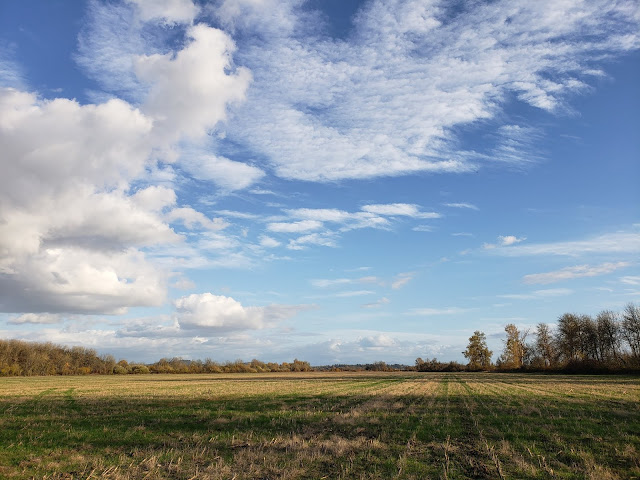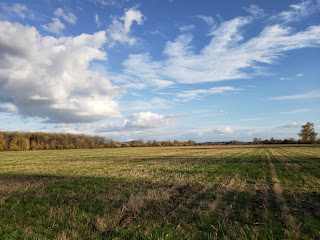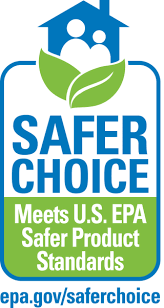Ankeny National Wildlife Refuge: Biography and Visit
Founded in 1964, the Willamette
Valley National Wildlife Refuge Complex became part of the Willamette Valley
Ecoregion (FWS, 2010 and DFW, 2006). The coordinates of the Ankeny Wildlife
Refuge are 122 degrees 36 minutes 44
seconds West Longitude, 45 degrees 05 minutes 18 seconds North Latitude (DFW,
2006) situating it between Salem and Albany, Oregon. Ankeny Wildlife Refuge
comprises a total of 2,796 acres; 1,765 acres of cropland, which provides
forage for wintering geese, 600 acres of riparian forests and 500 acres of
shallow water seasonal wetlands (FWS, 2011). A map of Ankeny Wildlife Refuge is
available at http://library.FWS.gov/Refuges/Ankeny_map.pdf. During my
research, I was unable to come across any information regarding major changes
to the boundaries of the Ankeny Wildlife Refuge.
 In the mid-twentieth century,
wildlife managers came to the consensus there was a need to take action against
the increasing limits imposed on the winter habitats for the Dusky Canada Goose
as well as the need for regulations regarding hunting the subspecies (FWS,
2010). The outcome of the consensus was the founding the Ankeny Wildlife
Refuge. The management goal is to provide wintering habitat for geese
particularly the dusky Canada goose (FWS, 2011). The subspecies Dusky of the Canada goose
breads in a small area of the south-central coast of Alaska, the Copper River
Delta, and Prince William Sound and Gulf of Alaska Island (FWS, 2010). With one
of the smallest populations amongst North America geese, Ankeny Wildlife Refuge
attempts to ensure a winter habitat that will provide for viable population
simultaneously, reducing damage to crops on private farmlands caused by
browsing geese (FWS, 2010, 2011).
In the mid-twentieth century,
wildlife managers came to the consensus there was a need to take action against
the increasing limits imposed on the winter habitats for the Dusky Canada Goose
as well as the need for regulations regarding hunting the subspecies (FWS,
2010). The outcome of the consensus was the founding the Ankeny Wildlife
Refuge. The management goal is to provide wintering habitat for geese
particularly the dusky Canada goose (FWS, 2011). The subspecies Dusky of the Canada goose
breads in a small area of the south-central coast of Alaska, the Copper River
Delta, and Prince William Sound and Gulf of Alaska Island (FWS, 2010). With one
of the smallest populations amongst North America geese, Ankeny Wildlife Refuge
attempts to ensure a winter habitat that will provide for viable population
simultaneously, reducing damage to crops on private farmlands caused by
browsing geese (FWS, 2010, 2011).
The founding of the Ankeny
Wildlife Refuge was a private decision. There was controversy between
landowners, hunters and wildlife agency personnel regarding hunting at Ankeny
Wildlife Refuge (Rasker, 1989). Currently the main purposes and uses of the
Ankeny Wildlife Refuge are wildlife/wildland observation, photography, hiking,
environmental education, and interpretation (FWS, 2011). The ability to hunt at
Ankeny Wildlife Refuge changed in 1980 with the suspension of this activity.
According to the U.S. Fish and Wildlife Service, there are over 160,000 annual
visitors to the Ankeny Wildlife Refuge.
Wetlands in the Ankeny National
Wildlife Refuge contain creeks, ponds and seasonal marshes that provide wetland
habitat to a variety of wildlife species. Riparian forests with its thick
understory provide habitat for various types of wildlife. Grasslands include
brush and hedgerows provide winter browse for winter waterfowl (FWS, 2010).
Research did not reveal any threats to the ecosystems of Ankeny Wildlife
Refuge.
In the wetlands of the complex of
Ankeny Wildlife Refuge, one can find broad-leafed pondweed, water plantain,
American sloughgrass, and Englemans spike-rush. One will find Oregon ash, lady
fern, and skunk cabbage in the riparian forests of the complex. Additionally, Found in the grasslands of the
complex are tall fescue, corn, annual ryegrass and hawthorn.
Found in the wetlands of Ankeny
National Wildlife Refuge are red-legged frog, pacific tree frog and beaver.
Found in the riparian forests are river otter, rough-skinned newt, black-tailed
deer, and red-legged frog. In addition, found in the grasslands are gray-tailed
vole, black-tailed deer, red fox, coyote and the common garter snake.
Wildlife is abundant at Ankeny
National Wildlife Refuge such as swans, geese and ducks species including,
cackling goose, Canada goose, American wigeon, Mallard, Cinnamon teal, northern
shoveler, northern pintail, green-winged teal, bufflehead, and ruddy duck (FWS,
2010). Moreover, one will find pheasants, grouse and quail species including
California quail and rarely ruffed grouse, blue grouse and mountain quail (FWS,
2010). Common birds include great blue heron, great egret, and occasionally
green heron (FWS, 2010). Turkey vultures are common (FWS, 2010). In addition,
falcons, rails, coots, pigeons, doves, owls, shrikes, vireos, jays, crows,
ravens, larks, swallows, chickadees, bushits, nuthatchers, creepers, wood
warblers, tanagers, sparrows, allies, and finches visit Ankeny National
Wildlife Refuge (FWS, 2010). The following link contains the Seasonal bird
checklist for the complex:
http://www.FWS.gov/willamettevalley/ankeny/documents/birdlist09heron.pdf .
http://www.FWS.gov/willamettevalley/ankeny/documents/birdlist09heron.pdf .
The number of dusky Canada goose
have varied over the decades starting with a population totaling two-thirds of
the geese in the Willamette Valley by 1950 increasing its population to more
than ninety percent the total geese by the mid-1960s. During the 1970s,
lessers, Taverner’s, western subspecies and cacklers began using the Willamette
Valley as a winter home. As a result, the dusky population declined while, for
instance, cackler population rose to make up eighty percent of the Willamette
Valley’s wintering population (FWS, 2010).
Dusky Canada goose are species of
concern making up ten percent of the 250,000 wintering geese in the Willamette
Valley; other major subspecies include Taverner’s, lesser, western subspecies
and rarely seen are the Aleutian and Vancouver subspecies (FWS, 2010). The
decline in population results from an earthquake in 1964 that uplifted their
habitat in Alaska leaving the Dusky with a small breeding ground in southern
Alaska. Furthermore, an increase in predation by Bald Eagles in particular
hinders the reproductive success of the Dusky as well as resulting in the death
of adults.
According to the National
Biological Information Infrastructure (2008), strict restriction on hunting the
Dusky Canada goose began in the 1980s. At Ankeny Wildlife Refuge prohibits
hunting of the Dusky. Additionally, the refuge closes during the overwintering
of the geese from Oct. – May. Moreover, for those hunters who hunt in the area where
the Dusky overwinter, must complete a special identification course before
receiving hunting tags for geese. Hunters must report to check stations for
inspection as a means of counting the number of geese killed. Additionally,
once the hunter has caught his limit, the hunting permit expires.
Ankeny National Wildlife Refuge
is one of three wildlife refuges that make up the larger Willamette valley
complex. The refuge incorporates local croplands as part of the browsing
grounds for overwintering geese and waterfowl. The ecosystem of the Ankeny
National Wildlife Refuge is a viable ecosystem because of its incorporation of
the surrounding private lands. Moreover, Ankeny National Wildlife Refuge is not
isolated from other areas that may serve as habitat for plant and animal
species. To the contrary, private croplands surround the refuge to the north,
west and south side. However, there is a major interstate approximately two
miles to the east of the refuge.
The U.S. Fish and Wildlife
Service (2011) proposed a plan to maintain the cooperation of cooperative
farmers by providing enhanced irrigation capabilities as wells taking over key
fields that the geese use. Additionally,
the U.S. Fish and Wildlife Service (2011) proposed, over the next fifteen
years, to restore roughly 479 acres (of the three refuges in the complex) to
wetland, wet prairie, riparian or upland prairie/oak savannah habitats.
I visited the Ankeny National
Wildlife Refuge located at 2301 Wintel Road, Jefferson, Oregon 97352. My visit
occurred on Saturday, May 21, 2011. During my visit, the weather conditions
were gray skies, cloud cover and light rain.
The
Ankeny National Wildlife Refuge is very accessible to the public. There are
well-maintained roads throughout the refuge with abundant signage denoting
wildlife viewing areas and parking areas. There are no visitor facilities
inside the refuge. Additionally, there is no entrance fee for Ankeny National
Wildlife Refuge. At the time of my visit, there were no visible signs of damage
to the refuge that resulted from visitors. In my opinion, there is adequate
access for visitors at Ankeny National Wildlife Refuge.
Visitors can find information
kiosks throughout the Ankeny National Wildlife Refuge. Each kiosk contains
information regarding the wildlife that is visible in each area. Each sign
details biological and migratory information about each fauna species.
Information signs for wild flora are also available for visitor education. I
found the information provided at the kiosks accurate and informative. The
kiosks located inside the Ankeny National Wildlife Refuge provided more
information about the biological and migratory information for migratory
species than I found during my research.
I did not find there to be any information gaps between the message
provided at the refuge kiosks and the information gathered during my research.
The low number of visitors
present during my visit to Ankeny National Wildlife Refuge surprised me. The
boardwalk that wound through the riparian area of the refuge provided the most
enjoyment for me during my visit. The boardwalk appeared to hover over the
still water underneath through which the trees descended and disappeared
underneath. Unfortunately, the lack of visitor facilities was not enjoyable,
particularly the lack of restrooms.
I found the Ankeny National
Wildlife Refuge valuable for the same reasons of its published formation,
namely, as a habitat for migratory and waterfowl birds as well as a variety of
manuals and reptiles. In addition, the refuge is home to various wild plant
species. In my opinion, the refuge is currently under proper management. As it
appears, the visitor areas are clean and well maintained, the wild plant
species are thriving and the wildlife is abundant. The main suggestion I have is
to increase the visitor facilities by providing at least one restroom inside
the Ankeny National Wildlife Refuge.
The Ankeny National Wildlife
Refuge in the Willamette Valley Ecoregion of Oregon is a vital component of the
Dusky Canada goose life, amongst other wildlife. The refuge provides
overwintering habitat and browse for migratory birds. It is impressive the
number of private farmers who came together to work with the U.S. Fish and
Wildlife Service in order to create the habitat for wild fauna and flora. It is reassuring to know resolving conflicts
is possible and outcomes such as the creation of the Ankeny National Wildlife
Refuge.
References:
National Biological Information
Infrastructure (2008) Canada Goose ‘Dusky’ subspecies, U.S. Geological Survey [online] http://www.nbii.gov/portal/server.pt/community/canada_goose_(dusky_ssp)/1629
Oregon Department of Fish and Wildlife
(2006) Willamette Valley Ecoregion, Oregon Conservation Strategy [online] http://www.dfw.state.or.us/conservationstrategy/document_pdf/b-eco_wv.pdf
Rasker, Raymond (1989) Agriculture and
wildlife: an economic analysis of waterfowl habitat management on farms in
western Oregon [online] http://ir.library.oregonstate.edu/xmlui/bitstream/handle/1957/11393/Rasker_Ray_1990.pdf?sequence=1
U.S. Fish and Wildlife Service (2005) Ankeny
National Wildlife Refuge: Public Use Facilities [online] http://library.FWS.gov/Refuges/Ankeny_map.pdf
U. S. Fish and Wildlife Service (2010)
Dusky Canada Geese, Willamette Valley National Wildlife Refuge Complex [online]
http://www.FWS.gov/willamettevalley/Complex/dusky.html
U. S. Fish and Wildlife Service (n.d.)
Providing compatible recreation at Willamette Valley Refuge [online] http://www.FWS.gov/willamettevalley/ccp/pub_use_issue.html
U.S. Fish and Wildlife Service (2011)
Welcome, Ankeny National Wildlife Refuge [online] http://www.FWS.gov/willamettevalley/ankeny/
U. S. Fish and Wildlife Service (2010)
Wildlife and Habitat, Ankeny National Wildlife Refuge [online]
U. S. Fish and Wildlife Service (2011) Willamette Valley
National Wildlife Refuge Complex, Benton, Linn, Marion, and Polk Counties,
Oregon, Federal Register [online]
http://www.federalregister.gov/articles/2011/05/25/2011-12964/willamette-valley-national-wildlife-refuge-complex-benton-linn-marion-and-polk-counties-or
Figure 1: U.S. Fish and Wildlife Service
(2005) Willamette Valley Ecoregion Conservation Opportunity Areas [online] http://www.dfw.state.or.us
Figure 2:U.S. Fish and Wildlife Service
(2011) Oregon coast national refuge complex: wildlife: waterfowl [online] http://www.fws.gov/oregoncoast/wildlife/waterfowl.htm
Figure 3: State Parks (n.d.) Ankeny
National Wildlife Refuge
http://www.stateparks.com/ankeny.html
http://www.stateparks.com/ankeny.html









Comments
Post a Comment